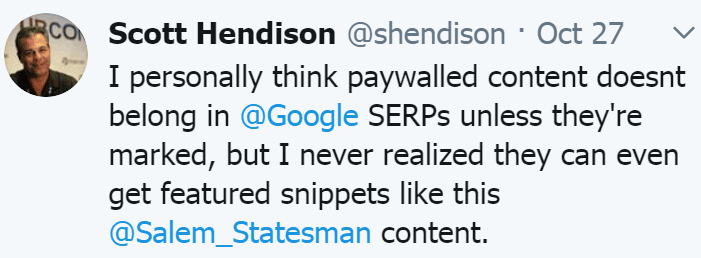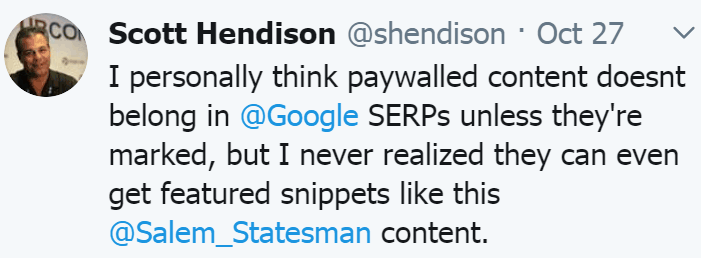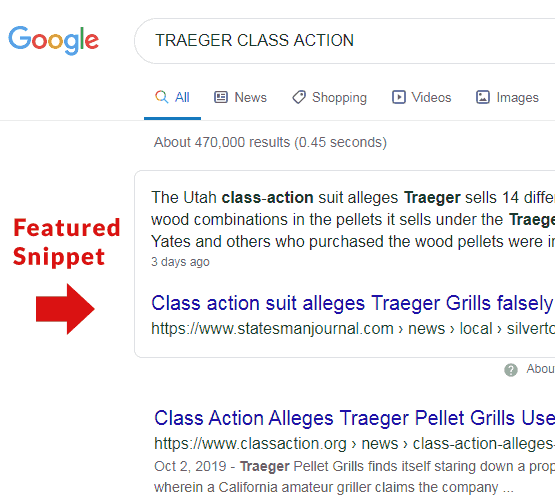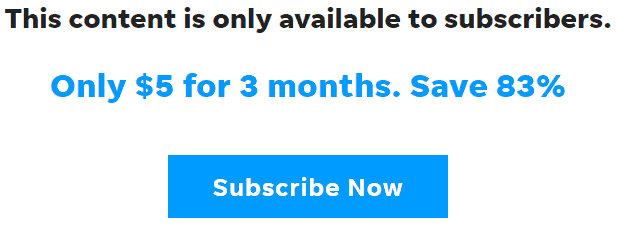Google Shows Paywall Content in Featured Snippets

A member of the search marketing community tweeted his surprise that Google ranked a paywalled web page in the featured snippets. Google’s official description of featured snippets precludes content that cannot be clicked through to be read.
But other documentation states that paywalled content is acceptable for Google Search as well as Google News. In addition to requirements for structured data that is missing, it’s unclear if this featured snippet is a mistake or if Google meant to do that.

Scott Hendison (@shendison) tweeted his opinion that paywalled content does not belong in Google search results.
“I personally think paywalled content doesnt belong in @Google SERPs unless they’re marked, but I never realized they can even get featured snippets like this
@Salem_Statesman content.”

This is a screenshot of the featured snippet that contains a paywalled web page that once clicked through does not display the content.
What is Paywalled Content?
Paywalled content is content that is available for the cost of a subscription. Only subscribers can read it.
Google shows paywalled content in Google News. The idea is that people who read the news will find value in subscribing to a newspaper to read the excellent content they are unable to see.
In Google’s Publisher Help Center Google has also said that paywalled content is allowed in Search and News.
So it appears that in fact, paywalled content is allowed to be shown in search. But there are rules that publishers are encouraged to follow.
What are the Rules for Paywalls?
According to Google, sites with Paywalls are encouraged to use structured data that indicates the content is paywalled.
Here is what Google’s official announcement from 2017 says of the structured data:
“Sites with paywalls are strongly encouraged to apply the new structured data to their pages, because without it, the paywall may be interpreted as a form of cloaking, and the pages would then be removed from search results.”
Google’s developer page for paywalled content and structured data says:
“This structured data helps Google differentiate paywalled content from the practice of cloaking, which violates our guidelines.”
Google recommends this section for the structured data that tells Google that a web page is behind a paywall:
“isAccessibleForFree”: “False”,
“hasPart”:
{
“@type”: “WebPageElement”,
“isAccessibleForFree”: “False”,
“cssSelector” : “.paywall”
That entire part of the code is “strongly encouraged” by Google to be in the structured data for paywalled content.
The news page that is ranking in Google’s featured snippets does not use the recommended structured data.
The structured data that is “strongly encouraged” is missing from the web page that is ranking in Google’s featured snippets. I visited the web page with my browser set to emulate Googlebot and reviewed the structured data the web page shows to Google. The “isAccessibleForFree” part was missing.
Additionally, according to Google’s publisher center help page, the publisher must use a “Flexible Sampling model” which allows users to sample a news page. But that may not be happening.
I visited the web page and was immediately blocked, even though I’ve never visited the web page. I checked with different browsers and I received the same message telling me I did not have access to the page. I was not allowed to sample any page. I was blocked and solicited for money.

Here is what Google’s Publisher Help Center says:
“As a result of our learning, we decided to transition from our FCF program and its fixed, free-sampling requirement to a Flexible Sampling model. Publishers determine their own optimal rate of sampling based on their ongoing experience using free samples to attract new users and using the paywall to elicit user registration or subscription.”
According to Google’s 2017 announcement, web sites are strongly encouraged to use the structured data. But that does not explicitly say they required to. Nevertheless, the Google Developer page says that web pages that lack the structured data could be removed if they are perceived as “cloaking” which is the practice of showing one page to Google and a different page to users.
Are Paywalls Supposed to be In Featured Snippets?
According to Google’s Help Center page about how featured snippets work, featured snippets are meant to be read as well as clicked so that a user can read the web pages. Google does not make an exception for paywalled web pages.

According to Google’s help page, a user is supposed to be able to click through the featured snippets and “read the page itself.”
A paywalled web page appears to be incompatible with featured snippets because a user cannot click through to read the web page.
Featured Snippets Issue is Complicated
- Paywalled content is allowed in Google Search.
- Paywalled content is does not conform with how featured snippets are supposed to work, by allowing users to click through and read the site.
- Web pages with paywalled content are strongly encouraged to use structured data to tell Google their pages are paywalled.
- But the paywalled web page in the featured snippets does not use the structured data, so that does that mean it’s presence is a mistake?
Lost in the confusion is the user experience. How do you feel about it? Should Google featured snippets allow paywalled content?


















